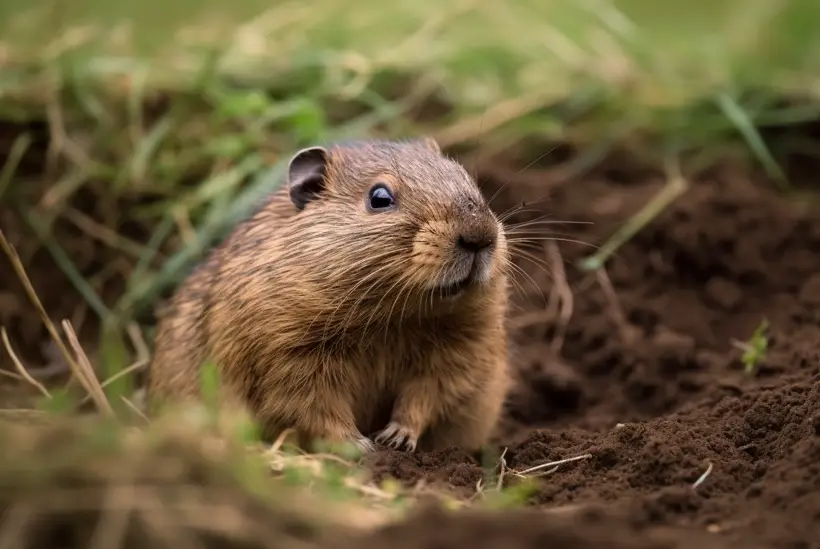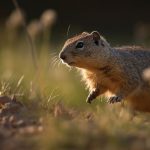When Are Gophers Most Active? (Everything You Need To Know!)
Gophers spend most of their time underground and only leave their tunnels when necessary if the weather allows. They are most active underground, and the impact is seen within days when crops wither and die.
But when are gophers most active? Gophers are most active when near the surface during spring or fall. They are crepuscular animals, most active in twilight or dusk. Gophers are nocturnal and diurnal, enabling them to surface even at night when most predators cannot see them.
Gophers cause havoc on crops and lawns by feeding on the roots and stem, leading to heavy losses. To control such damage, this article reviews the gopher activity patterns and how to prevent and control their infestation. In addition, it gives tips on how to detect their activities in the field.
Gopher Activity Patterns
When are gophers active? Gophers are most active between 12.00 am-04.00 am and 4.00 pm-8.00 pm.

- During the morning periods, they dispose of the waste accumulated overnight and engage in reproductive efforts.
- In the evening, they gather and store food for use overnight. For safety, gophers have minimal movement and maintain a one-skip distance from their tunnels.
- Regarding seasons, gophers are more active during spring or fall when the weather is favorable and crops in the field are mature.
- They also collect nesting materials during the spring in readiness for winter.
Having no other activities, gophers spend most time gnawing and chewing roots underground. The rest of the time, they are believed to mate and reproduce. Their reproduction rate is high throughout the year to counter their predation threat.
Factors That Influence Gopher Activity
Gophers may be mistaken to be lazy for spending most of their life underground. However, this is not the case. As gophers are still active, causing root damage to plants is part of their activities.

Its activities are affected by the following factors.
Weather Patterns
Gophers’ way of life is controlled and affected by the prevailing weather conditions. During rainy and cold seasons, they spend most of their time sleeping in the tunnels. Throughout these periods, they feed on stored food and underground roots.
When the spring falls, gophers resurface and can be seen busking in the sun. During this period, they gather food using their pockets and store it for future use.
Most gopher species mate during the spring or fall. However, some species reproduce all year through.
Soil Conditions
Loose sandy soil is the best for gophers as they find it easy to burrow and create channels in search of food. When the soil conditions favor them, you can easily detect mounds around the field.
When it rains and the soil gets heavy and sticky, most gophers retrieve and spend most of their time in burrows.
Prevailing Threats
Gophers will stay still in their deepest channels if they sense some threat. Little disturbances in their habitats trigger hibernation until normalcy resumes.
Wildlife behavior by snakes and weasels poses a threat to gophers. They block the channels and create divergence routes for escape. When under threat, they are mostly inactive and only come out at night.
Different species engage in various activities depending on the weather conditions and food availability. The southern pocket gophers are known to be active all day while foraging.
Detecting Gopher Activity – Signs Of Gopher Activity

To track gophers for control and eradication, one needs to understand the following signs of gopher activity for ease of detecting gopher activity.
- Burrowing: Gophers are burrowing rodents and live underground in tunnels they excavate. The animal burrowing behavior leaves heaps of mounds of soil pushed to the surface. Freshly mounded soil is an indication of recent gopher activities.
- Tunneling patterns: Fields attacked by gophers are full of underlying tunneling patterns that cause soil disturbance during food searches. You will notice the ground sinking when it rains or you step on these tunnels.
- Soil health disturbances: Since gophers live in underground tunnels, you can easily spot a piece of land with its standard soil structure destroyed and mounds formed on top.
- Plant damage: Gophers feed on the plant roots, which damages plants and crops. You will notice crops withering and dying from root disturbance from the top.
Methods For Detecting Gopher Activity

Use the following methods and techniques for detecting gophers in your garden.
Visual Inspections
Visual inspection early in the morning and late in the evening can help detect gophers’ activities. This is because gophers spend much of the day in tunnels and only come out in the evening and morning.
Frequent visits to the farm are the best inspection routine to help detect and control gophers in time. You will notice damage caused to the plant physiology and the mounds heaped on the surface.
Use Of Traps And Bait Stations
You can also set traps in the tunnels and wait for them to get hold of gophers. You may have to install several traps, as gophers keep changing patterns if they sense a disturbance.
Likewise, you can also set bait stations using the burrow builder along the tunnels, especially for huge pieces of land. Once gophers are trapped or poisoned, you can assess the situation and take necessary measures.
To distinguish gopher activities from other garden pests, such as moles, you need to assess the nature of burrows made in your garden. Gophers make wide and deep tunnels with several interconnections.
Gophers also have specific tunnels for specific roles, such as food storage, breeding, and dumping waste. Gophers also have long incisors as compared to moles and rats, which have short incisors.
Gopher Control And Prevention Measures
Gophers severely damage gardens, lawns, and the extensive ecosystem around them. Gopher control and prevention measures can be employed simultaneously to prevent infestation and eradicate the existing ones.

At times, gophers’ damage must be prevented and controlled to reduce gopher activity patterns in gardens using harmless control methods.
Best Practices For Preventing Gopher Damage To Gardens And Lawns

Let’s look at the best practices for harmless gopher damage control.
1. Use Of Garden Fencing
Garden fencing is one of the methods to prevent gopher damage to crops, especially young seedlings.
It involves erecting a fence 18 inches below the ground to exclude gophers. This method is efficient in large-scale wildlife management practices to keep pests from intruding into farms.
On the other hand, garden fencing to prevent gophers’ damage is expensive and labor-intensive.
It is uneconomical to erect a fence to protect a bare garden or for lawn maintenance.
2. Natural Pest Control Methods
You can employ natural garden pest control methods to prevent further damage in your garden.
- Crop rotation – Rotating different types of crops provides a harsh environment that hinders the multiplication of gophers. For example, one can rotate the alfalfa with cereal crops. Cereals do not have much to support gophers’ life.
- Planting grain buffer strips – Grain buffers around hay gardens and lawns are one of the best natural pest control methods. These discourage gopher existence and reduce their immigration into your farm.
- Practicing flood irrigation – Despite being expensive, it’s one of the best pest control methods to eradicate gophers. Water occupies the channels forcing gophers out. Also, when water gets wet, heavy, and sticky, gophers struggle to burrow.
Overview Of The Methods For Controlling Gopher Populations
Once gophers invade your garden, there is a need to control their spread and eventually drive them out of your space using the following methods.

1. Trapping
Trap traps are among the most convenient methods for controlling gophers and lawn damage. Follow the following steps to lay down traps.
- Identify sites with freshly dug mounds as sites for trap setting
- Excavate the mound to expose the tunnel. Ensure minimal disturbances to the surrounding
- Lay down two traps facing each direction
- Connect the traps to a support post on the ground surface to create tension on the traps
- Carefully cover the traps and level all other mounds for ease of identifying new mounds
2. Use Of Chemical Repellents
Using chemicals is the most economical method for large areas that gophers heavily infest. Alkaloid or Sulfate Strychnine is used as bait poison and is harmful to humans.
One can use a probe to identify points to insert roots and crops or cereals treated with strychnine to be consumed by gophers.
On the other hand, in substantial pieces of land, one can use a burrow builder to plant poisoned crops and cereals in the ground, hoping to intercept the gophers’ tunnels.
If you’re interested in learning more about gopher behavior and habits, you may want to check out our article on can gophers swim, which addresses the common question of whether gophers are capable of swimming. And if you’re looking for advice on how to locate gopher tunnels to set traps, our article on how to find gopher tunnels offers tips and techniques to help you find their underground burrows. For additional information on gopher behavior and control, be sure to also check out our article on when are gophers most active.FAQs
Let’s look at the frequently asked questions.
Q: Can Gophers Cause Damage To Underground Utility Lines And Pipes?
Yes. Besides damaging crop roots and vegetation by feeding on the roots and stems, gophers cause damage to underground utility lines and pipes. Gophers are known to gnaw and tear cable lines and pipes underground to burrow tunnels.
Q: Do Gophers Prefer Certain Types Of Soil Over Others?
Yes. Gophers prefer moist, loose sandy soil for ease of excavation. However, gophers can be found in hard and sticky soils, provided they have unlimited access to food.
Q: Are There Any Regulations Governing The Control And Prevention Of Gophers?
There are no well-laid-out regulations for gopher prevention and control around the globe. However, depending on their population size, gophers can be trapped or poisoned to control and eradicate them.
Conclusion
Gophers pose a threat to crops and the ecosystem around them. To eliminate this threat,
- One can prevent it by using natural methods or erecting garden fences to keep off the gophers
- For already-infested lands, consider eradicating gophers using chemicals and traps to kill them
This information helps control these rodents and nurture the ecosystem for maximum agricultural production and wildlife management.




